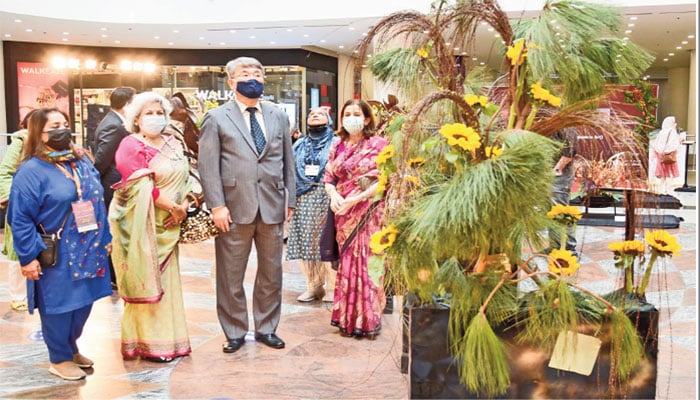Expressing hope through flower arrangements
A non-governmental organisation, Pakistan Blooms, joined hands with the Indus Sogestu Study Group and held a Sogestu Ikebana flower exhibition, titled ‘Bahar Ai’, to mark the advent of the spring season at the Karachi’s Lucky One Mall on Friday.
The exhibition was held to promote the Japanese flower arrangement extravaganza. Ikebana is the Japanese art of flower arrangement. It is also known as Kado. The tradition dates back to the Heian period when floral offering were made at altars.
Dignitaries and notable personalities including the consul general of Japan, Toshikazu Isomura, attended the event. The trainer at the event, Nafisa Tapal, director at the Indus Sogestu Study Group, has her more than 16 students teaching Ikebana around the world. She also teaches Ikebana at the Japanese consulate. In 1999, she became a teacher of Ikebana and held a big show at the FTC Building back then.
Nafisa has pioneered the study group of Ikebana in Pakistan. “Ikebana is a Japanese flower arrangements. The Sogestu is its most modern [technique],” she said explaining that in Sogestu, it doesn’t matter where and with what objects the artist makes the flower arrangement. “There’s no obligation to [make the arrangement] with flowers,” she pointed out. Sometimes, the arrangements are made with stones, dry branches and flowers as well.
The traditional Ikebana, according to her, was supposed to be placed at a particular place but Sogestu could be placed on stairs and even inside washrooms. “These [arrangements] can be displayed inside malls, shops and streets as well,” she said.
What makes Ikebana different? “Less is more,” she said adding that in the Ikebana arrangements, there should be as much gap in plants that a butterfly can fly through. “In Ikebana, there has to be hope in flower arrangement, and the hope should be blossoming,” she said. “Ikebana teaches you to be humble.”
In the exhibition the Sogestu arrangements are explaining different Urdu couplets. “Through poetry, we want to tell people how our poems can be depicted in the arrangements,” she said. The arrangements are mostly about spring so different Urdu couplets about the season have been explained in the arrangements in which budding flowers emerging from stems are shown.
Lahore Sugesto Study Group’s teacher Neveen Syed had her arrangements in the exhibition. “We selected one Urdu couplet and described it in out arrangements,” she said, adding that since there is the festival of spring, most of the couplets are about spring.
One of her arrangements has a yellow container and she painted all plant stems yellow from which flowers sprouted out, which she said, depicted hope. For another couplet “Millat Ke Sath Rabta Ustawar Rakh/ Pewasta Reh Shajar se, Umeed-e-Bahar Rakh [Keep a close contact with the nation; remain attached to the green and expect that the spring will come]”, she showed good people of society who are growing through budding flowers and beneath it there’s autumn, which she represented through dry woods and leaves.
This art work, she said, is like a flower meditation. “When you walk into learn, everything is calm and quiet,” she said, adding that in order to learn this art, one has to have a calm inner self and a peaceful environment. The exhibition will continue until Sunday, February 28.
-
 Timothy Busfield Booted From Penn Badgley Starrer Rom-com After Arrest
Timothy Busfield Booted From Penn Badgley Starrer Rom-com After Arrest -
 Sydney Sweeney Racy Movie Gets Attention After 'Euphoria' S3 Trailer
Sydney Sweeney Racy Movie Gets Attention After 'Euphoria' S3 Trailer -
 Sarah Ferguson Plans To Become Meghan 2.0 And Is Preparing To Go Totally Rogue On Royals
Sarah Ferguson Plans To Become Meghan 2.0 And Is Preparing To Go Totally Rogue On Royals -
 Brooklyn Beckham Speaks Out After 'relentless Inaccuracies About Nicola': Source
Brooklyn Beckham Speaks Out After 'relentless Inaccuracies About Nicola': Source -
 Leonardo DiCaprio Steps Out With Girlfriend After Golden Globes Roast
Leonardo DiCaprio Steps Out With Girlfriend After Golden Globes Roast -
 What Nicole Kidman's New Year Will Be Like After Keith Urban Divorce
What Nicole Kidman's New Year Will Be Like After Keith Urban Divorce -
 Nicola Peltz Remembers Designer Valentino After Wedding Dress Controversy
Nicola Peltz Remembers Designer Valentino After Wedding Dress Controversy -
 Amanda Seyfried Says Winning An Oscar Not A Priority
Amanda Seyfried Says Winning An Oscar Not A Priority -
 ‘Entitled’ Andrew Mountbatten-Windsor Is Still Winding People Up: ‘That’s What He’s Used To’
‘Entitled’ Andrew Mountbatten-Windsor Is Still Winding People Up: ‘That’s What He’s Used To’ -
 Why Sarah Ferguson Will Not Leave Andrew Despite Ultimate Humiliation
Why Sarah Ferguson Will Not Leave Andrew Despite Ultimate Humiliation -
 Sylvester Stallone Stuns Internet In New Video
Sylvester Stallone Stuns Internet In New Video -
 Sophie Turner Talks About ‘nesting’ In Early 20s: ‘Big Break’
Sophie Turner Talks About ‘nesting’ In Early 20s: ‘Big Break’ -
 Brooklyn Beckham Claims Family Blocked Him First In Bombshell Statement
Brooklyn Beckham Claims Family Blocked Him First In Bombshell Statement -
 Sarah Ferguson Resorts To A Cynical Attempt At Survival And Runa Out Of Lives
Sarah Ferguson Resorts To A Cynical Attempt At Survival And Runa Out Of Lives -
 Nicole Kidman 'calm' And Focused After Keith Urban Split
Nicole Kidman 'calm' And Focused After Keith Urban Split -
 Prince Harry Deserves UK Security: ‘Didn’t Choose His Fate’
Prince Harry Deserves UK Security: ‘Didn’t Choose His Fate’




